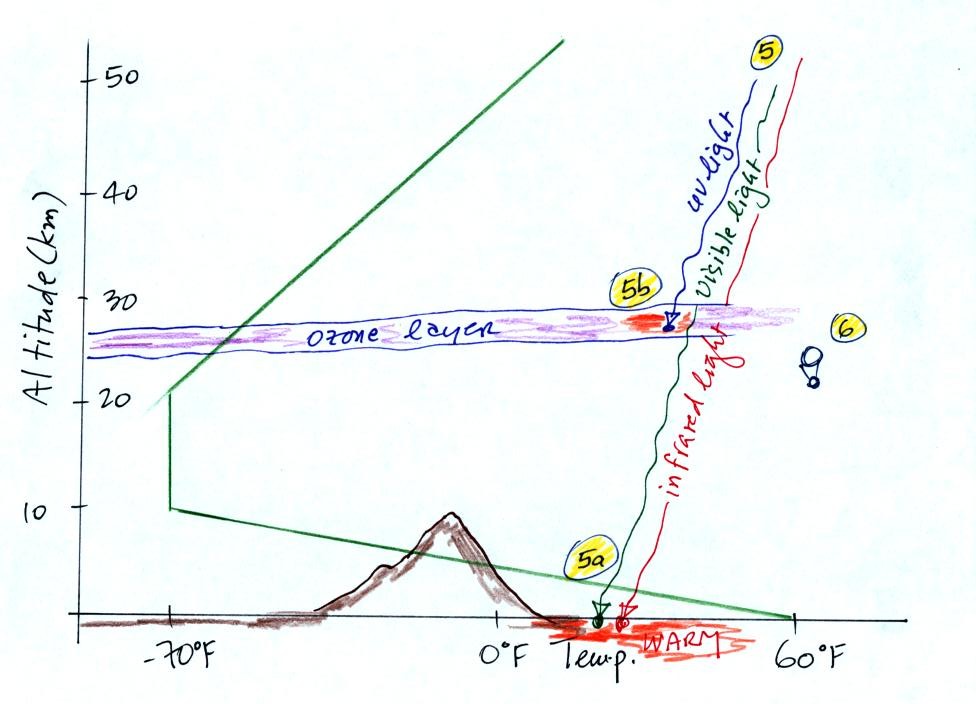So far we
have looked at how pressure and air density change with increasing
altitude. Next we had a quick look at how air temperature changes
with
altitude. The figure drawn in
class has been split into two parts and redrawn for
improved
clarity.
The atmosphere can be split
into layers
depending on whether
temperature is increasing or decreasing with increasing altitude.
The two lowest layers are shown in the figure above. There are
additional layers (the mesosphere and the thermosphere) above 50
km. You'll find them discussed in Dr. Ritchies notes but we
didn't discuss them in class.
1. We live in
the troposphere. The troposphere is found, roughly, between 0
and about 10 km altitude and is where temperature usually decreases
with
increasing altitude. [the troposphere is usually a little higher
in the tropics and lower at polar latitudes]
The troposphere contains most of the water vapor
in the atmosphere (the water vapor comes from evaporation of ocean
water) and is
where most of the clouds and weather occurs. The
troposphere can be stable or unstable (tropo means to turn over and
refers to the fact that air can move up and down in the
troposphere).
2a. The thunderstorm shown in
the figure indicates unstable conditions, meaning that strong up and
down air motions are occurring. When the thunderstorm reaches the
top of the troposphere, it runs into the bottom of the
stratosphere which is a very stable layer. The
air can't continue to rise into the stratosphere so the cloud
flattens out and forms an anvil (anvil is the name given to the flat
top of the thunderstorm). The
flat anvil top is something
that you can go outside and see and often marks the top of the
troposphere.
2b. The summit of Mt. Everest is a little over 29,000
ft. tall and is
close to the top of the troposphere.
2c. Cruising altitude in a passenger jet is usually between
30,000 and 40,000, near or just above the top of the troposphere, and
at the bottom of the stratosphere.
3. Temperature remains constant between 10 and 20 km
and then
increases with increasing altitude between 20 and 50 km. These
two sections form the stratosphere. The stratosphere is a
very stable air layer. Increasing temperature with increasing
altitude is called an
inversion. This is what makes the stratosphere so stable.
4. A kilometer is one
thousand meters. Since 1 meter is about 3 feet, 10 km is about
30,000 feet. There are 5280 feet in a mile so this is about 6
miles.
5. Sunlight is a mixture of ultraviolet (7%),
visible (44%), and
infrared light (49%). We can see the visible light.
5a. On average about 50% of the sunlight
arriving at the top of
the atmosphere passes through the atmosphere and is absorbed at the
ground (20% is absorbed by gases in the air, 30% isreflected back into
space). This warms the ground. The air in contact with the
ground is warmer than air just above. As you get further and
further from the warm ground,
the
air
is
colder
and
colder.
This
explains why air temperature decreases with increasing altitude in the
troposphere.
5b. How do you explain increasing temperature with
increasing
altitude in the stratosphere.
The ozone layer is found in the stratosphere
(peak concentrations are found near 25 km altitude). Absorption
of
ultraviolet light by ozone warms the air in the stratosphere and
explains why the air can warm. The air in the stratosphere is
much less dense (thinner) than in the troposphere. So even though
there is not very much UV light in sunlight, it doesn't
take as much energy to warm this thin air as it would to warm denser
air closer to the ground.
6. That's a manned
balloon;
Auguste Piccard
and Paul Kipfer are
inside. They were to first men to travel into the
stratosphere in May 1931. It really was quite a daring trip at
the time at the
time,
and they very
nearly didn't survive it. Auguste's son, Jacques, would later
descend to the deepest point in the ocean in a bathyscaph (part of a
two man team). Jacques' son Bertrand was part of the 2-man team
that first circled the globe non-stop in a balloon (March 1999).


